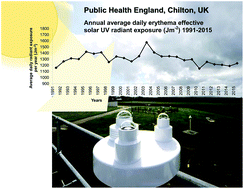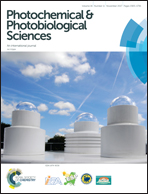Long term variations in erythema effective solar UV at Chilton, UK, from 1991 to 2015
Abstract
In this paper erythema effective UV radiant exposure data from the PHE solar network Chilton site for the 25 year period from 1991 to 2015 are presented. The year with the highest average daily erythema effective radiant exposure was 2003 at 1577 J m−2 and the year with the lowest average daily radiant exposure was 2010 at 1149 J m−2. Overall, the average daily radiant exposure per year ranged from 5655 J m−2 to 9.98 J m−2 with the average being 1306 J m−2. A preliminary analysis of the data set is carried out. A statistically significant (p = 0.01) increase in annual radiant exposure of 4.4% per year was observed from 1991–1995. Thereafter a small decrease in annual erythema effective radiant exposure of 0.8% (p = 0.002) per year was observed from 1995–2015 with a slightly faster rate of decrease from 2000–2015 of 1.0% (p = 0.007) per year. In terms of seasonal analyses, a statistically significant increase in erythema effective UV radiant exposure of 5.1% (p = 0.02) per year in the summer during 1991–1995 has been found along with small decreases in spring and summer during 1995–2015 (−1.0%; p = 0.01 and −0.7%; p = 0.01 respectively) and 2000–2015 (−1.1%; p = 0.03 and −1.2%; p = 0.003 respectively). The data suggest that the erythema effective UV dose available for impacting public health has been decreasing in recent years.



 Please wait while we load your content...
Please wait while we load your content...